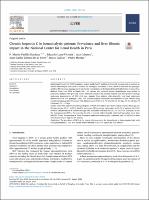| dc.contributor.author | Padilla-Machaca, P. Martin | |
| dc.contributor.author | Luna-Victoria, Eduardo | |
| dc.contributor.author | Cabrera, Ada | |
| dc.contributor.author | Gómez De la Torre, Juan Carlos | |
| dc.contributor.author | Galloso, Rocio | |
| dc.contributor.author | Montes, Pedro | |
| dc.date.accessioned | 2023-03-21T17:27:38Z | |
| dc.date.available | 2023-03-21T17:27:38Z | |
| dc.date.issued | 2022-09 | |
| dc.identifier.citation | Iliver. 2022. 1(3). | es_PE |
| dc.identifier.issn | 2772-9478 | |
| dc.identifier.uri | https://hdl.handle.net/20.500.12959/3480 | |
| dc.description.abstract | Background: Hepatitis C (HCV) remains a serious public health problem in high-risk persons such as patients on chronic hemodialysis. We aimed to estimate the serological prevalence of HCV, the HCV viral load and genotype, and liver fibrosis stage among patients on chronic hemodialysis at the National Renal Health Center in Lima, Peru.
Methods: From June 2019 to March 2021, all patients who received chronic hemodialysis were invited to participate. Subjects who provided written informed consent were enrolled. Patients with HCV-positive serology underwent determination of HCV viral load. Samples from subjects with detectable viral load, underwent determination of HCV genotype. Then, HCV infected subjects underwent determination of liver fibrosis using transitional elastography (Fibroscan 402): Metavir score: F0–F1: 2.5–7.5 kPa, F2: 7.6–9.5 Kpa, F3: 9.6–12 Kpa, F4 (Cirrhosis): 12.1–75 Kpa.
Results: Of the 303 subjects invited to participate, 174 (57.4%) subjects gave their written consent. Mean age was 52 years (range 22–91) and 116 (66.6%) were male. HCV serology was positive in 35.1% of patients (61/174); however, the prevalence of positive serology with detectable viral load was 20.11% (35/174). Genotype 1a was the most prevalent (85%). The majority (83.6%) of subjects with detectable viral load had values lower than 800.000 IU/mL. Twenty-nine of those 35 subjects underwent elastography evaluation, and 13 (44.8%) of them were found to have stage F2–F4 fibrosis.
Conclusions: The prevalence of HCV at the largest reference center for hemodialysis in Lima remains high, with GT1a predominance, viral load usually below 800,000 IU/mL and significant liver fibrosis. | es_PE |
| dc.description.abstract | La hepatitis C (VHC) sigue siendo un grave problema de salud pública en personas de alto riesgo, como los pacientes en hemodiálisis crónica . Nuestro objetivo fue estimar la prevalencia serológica del VHC, la carga viral y el genotipo del VHC y el estadio de fibrosis hepática en pacientes en hemodiálisis crónica en el Centro Nacional de Salud Renal en Lima, Perú.
Métodos: Desde junio de 2019 hasta marzo de 2021, se invitó a participar a todos los pacientes que recibieron hemodiálisis crónica. Se inscribieron sujetos que dieron su consentimiento informado por escrito. A los pacientes con serología VHC positiva se les realizó determinación de carga viral VHC. Las muestras de sujetos con carga viral detectable se sometieron a la determinación del genotipo del VHC. Luego, los sujetos infectados con el VHC se sometieron a la determinación de la fibrosis hepática mediante elastografía de transición (Fibroscan 402): Metavir score: F0–F1: 2,5–7,5 kPa, F2: 7,6–9,5 Kpa, F3: 9,6–12 Kpa, F4 (cirrosis): 12,1 –75 Kpa.
Resultados: De los 303 sujetos invitados a participar, 174 (57,4%) sujetos dieron su consentimiento por escrito. La edad media fue de 52 años (rango 22-91) y 116 (66,6%) eran varones. La serología VHC fue positiva en el 35,1% de los pacientes (61/174); sin embargo, la prevalencia de serología positiva con carga viral detectable fue de 20,11% (35/174). El genotipo 1a fue el más prevalente (85%). La mayoría (83,6%) de los sujetos con carga viral detectable tenían valores inferiores a 800.000 UI/mL. Veintinueve de esos 35 sujetos se sometieron a una evaluación de elastografía y se encontró que 13 (44,8 %) de ellos tenían fibrosis en estadio F2-F4.
Conclusiones: La prevalencia de VHC en el mayor centro de referencia para hemodiálisis de Lima sigue siendo alta, con predominio de GT1a, carga viral generalmente por debajo de 800.000 UI/mL y fibrosis hepática significativa. | es_PE |
| dc.format | application/pdf | es_PE |
| dc.language.iso | eng | es_PE |
| dc.publisher | Ministry of Education of the People's Republic of China | es_PE |
| dc.relation.uri | https://www.sciencedirect.com/science/article/pii/S2772947822000391 | es_PE |
| dc.rights | info:eu-repo/semantics/openAccess | es_PE |
| dc.rights.uri | https://creativecommons.org/licenses/by-nc-sa/4.0/ | es_PE |
| dc.subject | Hepatitis C | es_PE |
| dc.subject | Hemodialysis | es_PE |
| dc.subject | Liver fibrosis | es_PE |
| dc.subject | HCV genotype | es_PE |
| dc.subject | Hemodiálisis | es_PE |
| dc.subject | Fibrosis hepática | es_PE |
| dc.subject | Genotipo del VHC | es_PE |
| dc.title | Chronic hepatitis C in hemodialysis patients: Prevalence and liver fibrosis impact in the National Center for Renal Health in Peru | es_PE |
| dc.title.alternative | Hepatitis crónica C en pacientes en hemodiálisis: prevalencia e impacto de la fibrosis hepática en el Centro Nacional de Salud Renal del Perú | es_PE |
| dc.type | info:eu-repo/semantics/article | es_PE |
| dc.subject.ocde | https://purl.org/pe-repo/ocde/ford#3.02.19 | es_PE |
| dc.identifier.doi | https://doi.org/10.1016/j.iliver.2022.08.001 | |






